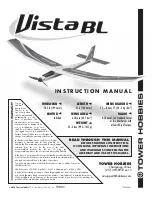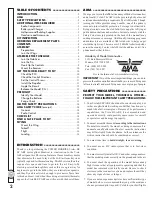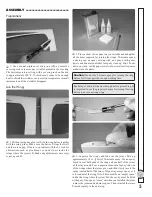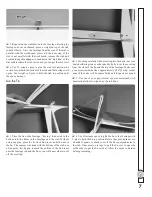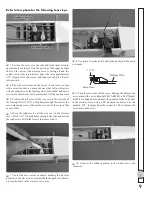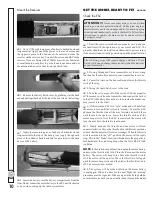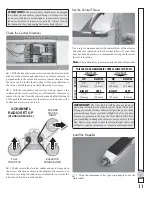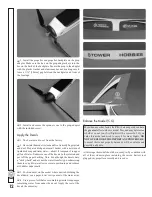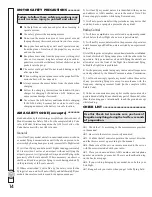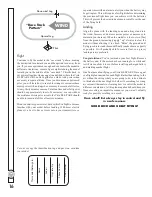
15
FIND A SAFE PLACE TO FLY –––––––––––
The best place to
fl
y any model is at an AMA chartered club
fi
eld. Club
fi
elds are set up for R/C
fl
ying, making your outing
safer and more enjoyable. We recommend that you join the AMA
and a local club so you can have a safe place to
fl
y and have
insurance to cover you in case of a
fl
ying accident. The AMA
address and telephone number are in the front of this manual.
If there is no club or R/C
fl
ying
fi
eld in your area,
fi
nd a suitable
site that is clear of trees, telephone poles, buildings, towers, busy
streets and other obstacles. Since you are not
fl
ying at a sanctioned
AMA site, be aware that there may be others like yourself who
could be
fl
ying nearby. When
fl
ying on 72MHz, if both of your
models happen to be on the same frequency, interference will
likely cause one or both of the models to crash. An acceptable
minimum distance between
fl
ying models is
fi
ve miles, so keep
this in mind when searching for a
fl
ying site.
In addition to obstacles, it is important to be aware of people who
may wander into the area once you begin
fl
ying. At AMA club
fl
ying sites it is a severe rule infraction to
fl
y over others and this
is a good practice if
fl
ying elsewhere. R/C models tend to attract
onlookers who may pose two main problems;
fi
rst is the danger
of actually crashing your model into a person, causing injury.
Second is the distraction by those who ask you questions while
you are trying to concentrate on
fl
ying. To minimize or avoid this
problem, have an assistant standing by who can spot people who
wander into your
fl
ying site (so you can avoid
fl
ying over them)
and who can perform “crowd control” if people start to gather.
FLYING ––––––––––––––––––––––––––––––––––
Mount the Wing
Mount the wing to the fuselage with the ten (10) #64 rubber
bands that came with the model. Install them one at a time,
crisscrossing the last two. Never use torn, cracked or oily
rubber bands.
If the rubber bands you will be using are different from those
recommended, consult an experienced modeler to make certain
they are strong enough, and that you have used enough of them.
If uncertain, force the front of the wing off of the wing saddle.
There should be considerable resistance! If the wing can be
forced from the fuselage without having to strain your hands,
then there are probably not enough rubber bands.
IMPORTANT!!!
Flying a model with too few rubber bands
can be dangerous. The wing could actually detach from
the fuselage resulting in a crash. If the model exhibits any
tendencies that indicate there are not enough rubber bands,
immediately land and closely inspect the model for damage.
If no damage is found, add more rubber bands.
Takeoff
IMPORTANT:
If you are an inexperienced modeler we strongly
urge you to seek the assistance of a competent, experienced R/C
pilot to check your model for airworthiness AND to teach you
how to
fl
y. No matter how stable or “forgiving” the Vista BL ARF
is, attempting to learn to
fl
y on your own is dangerous and may
result in destruction of your model or even injury to yourself
and others. Therefore,
fi
nd an instructor and
fl
y only under his or
her guidance and supervision until you have acquired the skills
necessary for safe and fully controlled operation of your model.
WIND
Pilot
Launch
Assistant
The Vista BL EP ARF may be self-launched by the pilot, but if
you are a beginner it will be easier to have an assistant launch
the Vista BL EP ARF for you. Switch on the transmitter, throttle
stick in bottom position, then plug the motor battery into the
ESC. Hold the fuselage under the wing. Before
fl
ying any model,
always check to be certain that all the controls are operating
and in the correct direction by moving the control sticks on
the transmitter and observing their response. Once you have
con
fi
rmed that the controls are operating correctly, point the
nose into the wind and apply full power. Toss the model into
the air at a nose-level or slightly nose-up attitude. The model
should climb gently, but be ready on the controls to keep the
wings level and model on a straight-out, slightly nose-up ascent.
Reduce the throttle to half. Once at a comfortable altitude, use
rudder and elevator trim as necessary to get the Vista BL EP
ARF to
fl
y straight-and-level when the control sticks are neutral.
When the model has reached enough altitude (50 to 100 feet [15
to 30m]) make the
fi
rst turn away from yourself and the takeoff
area. Continue to control the model, keeping it on the intended
fl
ight path while climbing at a comfortable rate.

